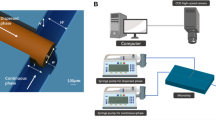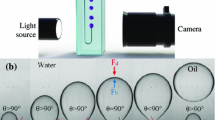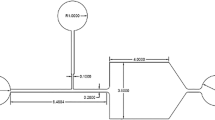Abstract
The microfluidic production of droplets is a well controllable process, which allows templating small spherical containers that can subsequently be transferred into uniformly sized polymer microgel particles by a crosslinking reaction. Recently, the per-channel production rate of N-isopropylacrylamide (NIPAAm) droplets (w-phase) dispersed in a low-viscosity fluorocarbon oil (o-phase) could be increased by a delayed surfactant addition, while maintaining the advantageous dripping regime. Here it should be evaluated, if delayed surfactant addition can be applied to enhance droplet production also for high viscosity continuous phases, which is associated with a change to an inviscid drop scenario compared to the previously used setting of viscous drops. It could be illustrated that the concept of delayed surfactant addition holds true also for viscous continuous phases and allows ∼8 fold increased flow rates in the dripping regime. Surprisingly, the droplet size increased at higher total flow rate with constant flow rate ratios of w- and o-phases, which is discussed in the light of viscous dissipation, microchannel bulging and viscosity of the continuous phase. More rigid microchannels such as from glass may allow further exploring this phenomenon in the future.
Similar content being viewed by others
References
C. N. Baroud, F. Gallaire and R. Dangla, Lab Chip 10, 2032 (2010).
E. Y. Basova and F. Foret, Analyst 140, 22 (2015).
S. Seiffert, Angew Chem Int Edit 52, 11462 (2013).
G. T. Vladisavljević, N. Khalid, M. A. Neves, T. Kuroiwa, M. Nakajima, K. Uemura, S. Ichikawa and I. Kobayashi, Advanced Drug Delivery Reviews 65, 1626 (2013).
S. Seiffert, F. Friess, A. Lendlein and C. Wischke, J Colloid Interface Sci 452, 38 (2015).
A. S. Utada, A. Fernandez-Nieves, H. A. Stone and D. A. Weitz, Phys Rev Lett 99 (2007).
T. Ward, M. Faivre, M. Abkarian and H. A. Stone, Electrophoresis 26, 3716 (2005).
C. A. Stan, S. K. Y. Tang and G. M. Whitesides, Anal Chem 81, 2399 (2009).
J. M. Koo and C. Kleinstreuer, J Micromech Microeng 13, 568 (2003).
B. H. Weigl, R. L. Bardell and C. Cabrera, “Introduction to Microfluidic Techniques”, Handbook of Biosensors and Biochips (John Wiley & Sons, Ltd2008).
H. H. Winter, “Viscous dissipation term in energy equations”, Modular Instruction, Series C: Transport, Volume 7: Calculation and Measurement Techniques for Momentum, Energy, and Mass Transfer, Module C 7.4 ed. R. J. Gordon (American Institute of Chemical Engineers1987), pp. 27.
R. Dangla, F. Gallaire and C. N. Baroud, Lab Chip 10, 2972 (2010).
M. A. Holden, S. Kumar, A. Beskok and P. S. Cremer, J Micromech Microeng 13, 412 (2003).
P. A. Romero and A. R. Abate, Lab Chip 12, 5130 (2012).
T. Cubaud, B. M. Jose, S. Darvishi and R. P. Sun, Int J Multiphas Flow 39, 29 (2012).
Author information
Authors and Affiliations
Rights and permissions
About this article
Cite this article
Friess, F., Lendlein, A. & Wischke, C. Two phase microfluidics with inviscid drops: Effects of total flow rate and delayed surfactant addition. MRS Advances 1, 2019–2024 (2016). https://doi.org/10.1557/adv.2016.493
Published:
Issue Date:
DOI: https://doi.org/10.1557/adv.2016.493




